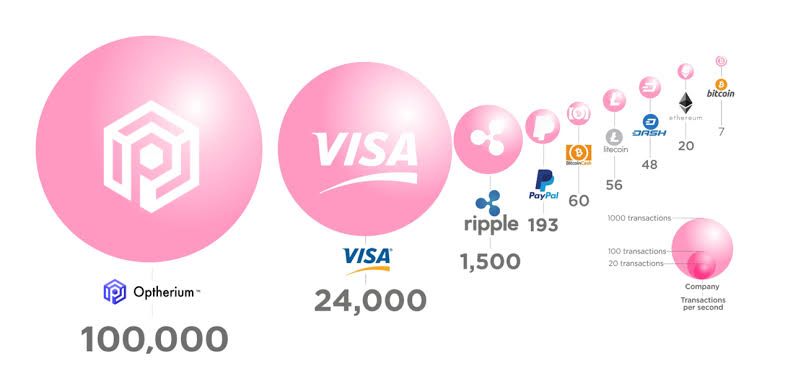What is Transactions Per Second (TPS) in Blockchain? TPS Fully Explained
Reading blockchain-related news must have you familiar with the phrase “transactions per second,” or “TPS,” rather often. With different networks recording different TPS, this is a typical phrase used to evaluate the performance of a blockchain.
Start reading this article if you’re wondering why this seems fascinating term is among the most sought-after metric in Web3 since it is actually interesting and vital to grasp the major influence it performs in the domains of blockchain technologies and other distributed ledger systems.
What is Transactions Per Second?
In the context of cryptocurrencies, Transactions Per Second (TPS) is the assessment of the one-second temporal capacity of a blockchain network for processing of transactions. Reflecting the network’s capacity to manage a great volume of transactions and preserve optimal performance, it is a vital indicator of the scalability and efficiency of a blockchain.
Given that it directly affects the speed at which transactions are verified and added to the blockchain, the Transactions Per Second statistic is very pertinent in the debate of blockchain scalability. A greater TPS shows that a network can allow more transactions in a shorter period, therefore improving the user experience and facilitating more general adoption.
Several elements affect the Transactions Per Second measure: block size, block time, general network architecture, and consensus mechanism. Various consensus mechanisms—such as Proof of Work (PoW), Proof of Stake (PoS), or Delegated Proof of Stake (DPoS)—which different blockchain networks use affect TPS in different ways. For instance, since PoW usually takes longer time to validate transactions, networks running PoW—like Bitcoin—may have lower Transactions Per Second than those running PoS or DPoS.
Crucially important are also block size and block duration. More transactions to be included in each block made possible by a bigger block size could possibly raise TPS. In a same vein, a reduced block time produces more frequent block production, hence improving the Transactions Per Second.

By offloading some transactions from the main blockchain, scalability solutions—such as layer-2 solutions (e.g., the Lightning Network for Bitcoin) seek to solve scalability issues and improve TPS.
Optimising TPS becomes critical to guarantee effective and cheap transactions as acceptance of cryptocurrencies rises and blockchain networks face more demand. Higher TPS is a continuing target for blockchain development; new ideas and improvements are always under investigation to balance security, scalability, and decentralisation.
One problem that has sort of stood in the way of mainstream blockchain technological adoption is scalability. Blockchain networks are rather slower than conventional transactional processing systems. For example, the throughput of Bitcoin might reach 5–10 TPS. Regarding Ethereum, its TPS falls between 20-30. Even the more current networks handle, on average 400 TPS. Meanwhile, established payment systems and social apps like Visa and Meta (Facebook) can handle 4000 TPS on average.

Factors Influencing Transactions Per Second
1. Self-imposed Block Limits
Blockchain network Transactions Per Second depends on several elements. Block size comes first among the most crucial ones. Greater block sizes let a network handle more transactions every second. Second, shorter validation intervals in blockchain systems can also guarantee more throughput. That comes at the price of security or decentralisation though.
Because of its just fixation with security, Bitcoin, for example, has a smaller block size and longer block production time. More modern networks change their designs to reach great scalability while still restricting their bounds to stop hostile attack routes.
Remember, in the wake of the 2008 financial crisis, Bitcoin and other early blockchain networks emerged as means to mitigate the negative effects of conventional centralised institutions, such banks and big tech, repeatedly using their power to inflict widespread losses on the general public. Consequently, by basically restricting their scalability potential, blockchain networks began evolving their protocols targeted on decentralisation and security.
2. Vertical Scaling
Limiting Transactions Per Second finally causes network congestion. More networks chose to scale vertically comparable to conventional systems in order to decongest and raise scalability. Scaling vertically entails far higher CPU, RAM, and storage capacity of current servers.
Only limited users can thus afford to run a node at that stage. Nodes began prioritising and processing transactions in order of highest fees paid by end users instead of processing transactions in the sequence they were received leading to inflated fee markets when network congestion resulted in higher costs to operate a node coupled with the great demand for limited block space.
And since public blockchains document transactions on public ledgers open to anybody, additional unpleasant outcomes started running amok – front-running and MEV. Vertical scaling causes transactions per second (TPS) to reach a ceiling whenever blockchains see more demand, therefore limiting future throughput and leading to outages and transaction price increases.
3. Mechanism of Consensus
Recall that public participants—nodes who run computer servers—are what enable permissionless, public blockchains to reach consensus on the legitimacy and sequencing of transactions. Therefore, the consensus technique applied and the speed and efficiency of validation and network addition determine directly the Transactions Per Second of a blockchain. Bitcoin’s Mechanisms like Proof of Work (PoW) might be slower and more resource-intensive, therefore lowering its throughput and scalability capability.
Also Read: Discover DApps: A foremost Beginner’s Guide to Decentralized Applications
Factors Enhancing Second-Term Transaction Performance
Industry players are always creating fresh ideas to handle the continuous problems with scalability and throughput. These solutions will become quite important as the blockchain technology develops towards general acceptance.
1. Level 2 Solutions
Built upon top of layer 1 systems like Ethereum, layer 2 solutions are protocols. By shifting transaction processing from the main blockchain (Layer 1) to subsidiary layers, they assist raise Transactions Per Second. These methods reduce congestion and let the main blockchain to validate transactions more effectively by handling transactions independently and then batch or roll-up the results to the main chain. This greatly increases the transaction throughput generally.
2. Blockless Architectures
By removing the conventional block-based construction, blockless designs greatly increase TPS in blockchain systems. Under blockless systems—that is, those based on a Directed Acyclic Graph (DAG—where transactions are connected straight to one another instead of being arranged into blocks)— Since every new transaction validates one or more past transactions, this enables parallel processing of transactions, hence lowering confirmation times and raising throughput. Eliminating blocks helps to clear block creation and propagation-related bottlenecks, therefore allowing the network to scale more effectively and manage a greater transaction volume every second.
3. Parallel Transaction Execution
Parallel transaction execution greatly improves the transactions per second (TPS) in blockchain by letting several transactions to be handled concurrently instead of sequentially, as advised in the past sections. This method better uses CPU and memory more consistently across network nodes, hence increasing throughput and general efficiency. Parallel processing enabled by blockchains helps them to manage a much higher transaction volume, therefore enhancing the general network scalability.
4. Sharding
By separating the blockchain network into smaller, parallel pieces known as shards at the primary layer, sharding aids in Transactions Per Second increase. Every shard independently handles smart contracts and its own transactions, therefore enabling several simultaneous processing of transactions. By lowering the total network load, this parallelism greatly increases transaction throughput and scalability.
5. Effective Consensus Systems
Simplifying transaction validation and network communication helps mechanisms like Proof of Stake (PoS) and the Gossip protocol improve TPS. PoS chooses validators depending on their staked tokens, so greatly less computing time and effort is required to build and validate blocks than in PoW.
Conversely, the technologies like Gossip protocol guarantee speedier consensus by allowing quick and effective distribution of transaction and block information around the network. These systems taken together raise the blockchain network’s speed and efficiency, hence increasing transactions per second.
6. Horizontal or Linear Scalability
The ideal rate of transaction processing in the network should be commensurate with network node count. Unlike vertical scaling, boosting throughput implies increasing the number of nodes (horizontal scaling). This method greatly increases the capacity of the network by spreading the transaction load among several nodes continuously, therefore enabling concurrent transaction processing.
In the field of distributed ledger technology, horizontal scalability is quite difficult to reach as no one silver bullet a network can utilise to do so. Implementing an ideal architecture and consensus process, including lightweight validator nodes, and using cutting-edge technologies like sharding and auto-scaling calls for networks to have.
On the other hand, when a network reaches linear scalability, the transaction processing capacity of the system scales in direct proportion to the number of nodes, therefore preserving and preferably improving transaction speeds as the network develops.
Does the Effectiveness of a Blockchain Network Depend just on TPS?
Though it is a good indicator of the performance of a blockchain, TPS (transactions per second) is not the only determinant of network efficiency. Other important factors are latency, which influences the speed of transaction confirmation and general user experience; scalability, which guarantees the network’s capacity to expand and control higher demand by more nodes or additional layers; and security, so ensuring the integrity and trustworthiness of the network against attacks and fraud. These components taken together help a blockchain platform to be totally dependable and efficient.

Final Thoughts
In essence, the adoption of a blockchain in real-world applications especially in sectors including gaming, supply chain, exchanges, social media, telecommunications among others depends on its capacity to manage a high Transaction Per Second (TPS) rate.
TPS directly affects the scalability of a blockchain, which qualifies for general application in many different sectors as it rises. Therefore, improving Transaction Per Second is not only a technical achievement but also a necessary step towards achieving mass adoption since it guarantees the network can support the demands of large-scale, practical applications efficiently and reliably in a distributed way – an all-encompassing attribute traditional Web2 systems lack, accelerating the demand for decentralisation in first place!






One Comment